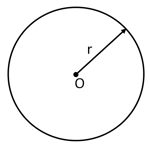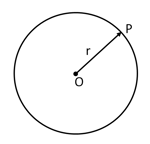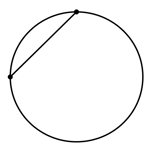The region enclosed by a chord and the minor arc is minor segment.

Important Points to Remember in Chapter -1 - Circles from Telangana Board Mathematics Class 9 Solutions
1. Circle:
(i) A circle is the collection of those points in a plane that are at a given constant distance from a given fixed point in the plane. The fixed point is called the centre and the given constant distance is called the radius of the circle.

(ii) There is one and only circle passing through three given non-collinear points.
2. Position of a Point with respect to Circle:
A point lies inside or on or outside the circle according to as or or

3. Circular Disc:
The collection of all points lying inside and on the circle is called a circular disc with centre and radius
4. Concentric Circles:
Circles having the same centre and different radii are said to be concentric circles.
5. Arc of a Circle:
(i) A continuous piece of a circle is called an arc of the circle.
(ii) The length of an arc is the length of the fine thread which just covers it completely.
(iii) Let be any circle. Then any angle whose vertex is is called the central angle.
(iv) A minor arc of a circle is the collection of those points of the circle that lie on and inside the arc central angle.
(v) A major arc of a circle is the set of points of the circle that lie on or outside a central angle.
(vi) The angle subtended by an arc of a circle at the centre is double the angle subtended by it at any point on the remaining part of the circle.
(vii) A diameter of a circle divides it into two equal parts which are arcs. Each of these two arcs is called a semi-circle.
(viii) Angles in the same segment of a circle are equal.
(ix) The angle in a semi-circle is a right angle.
6. Chord of a Circle and Theorems based on it:
(i) A line segment joining any two points on a circle is called a chord of the circle.

(ii) A chord passing through the centre of a circle is known as its diameter.
(iii) If two arcs of a circle are congruent, then corresponding chords are equal.
(iv) If two chords of a circle are equal, then their corresponding arcs are congruent.
(v) The perpendicular from the centre of a circle to a chord bisects the chord.
(vi) The line segment joining the centre of a circle to the mid-point of a chord is perpendicular to the chord.
(vii) If two circles intersect in two points, then the line through the centres is perpendicular to the common chord.
(viii) Equal chords of a circle are equidistant from the centre.
(ix) Chords of a circle which are equidistant from the centre are equal.
(x) Equal chords of a circle subtend equal angle at the centre.
(xi) If the angles subtended by two chords of a circle at the centre are equal, the chords are equal.
(xii) Of any two chords of a circle, the larger chord is nearer to the centre.
(xiii) Of any two chords of a circle, the chord nearer to the centre is larger.
7. Congruent Circles:
Two circles are said to be congruent if either of them can be superposed on the other so as to cover it exactly.
8. Cyclic Quadrilateral:
(i) If all vertices of a quadrilateral lie on a circle, it is called a cyclic quadrilateral.
(ii) The opposite angles of a cyclic quadrilateral are supplementary.
(iii) If the sum of any pair of opposite angles of a quadrilateral is , then it is cyclic.
(iv) If one side of a cyclic quadrilateral is produced, then the exterior angle is equal to the interior opposite angle.
(v) An isosceles trapezium is cyclic.
